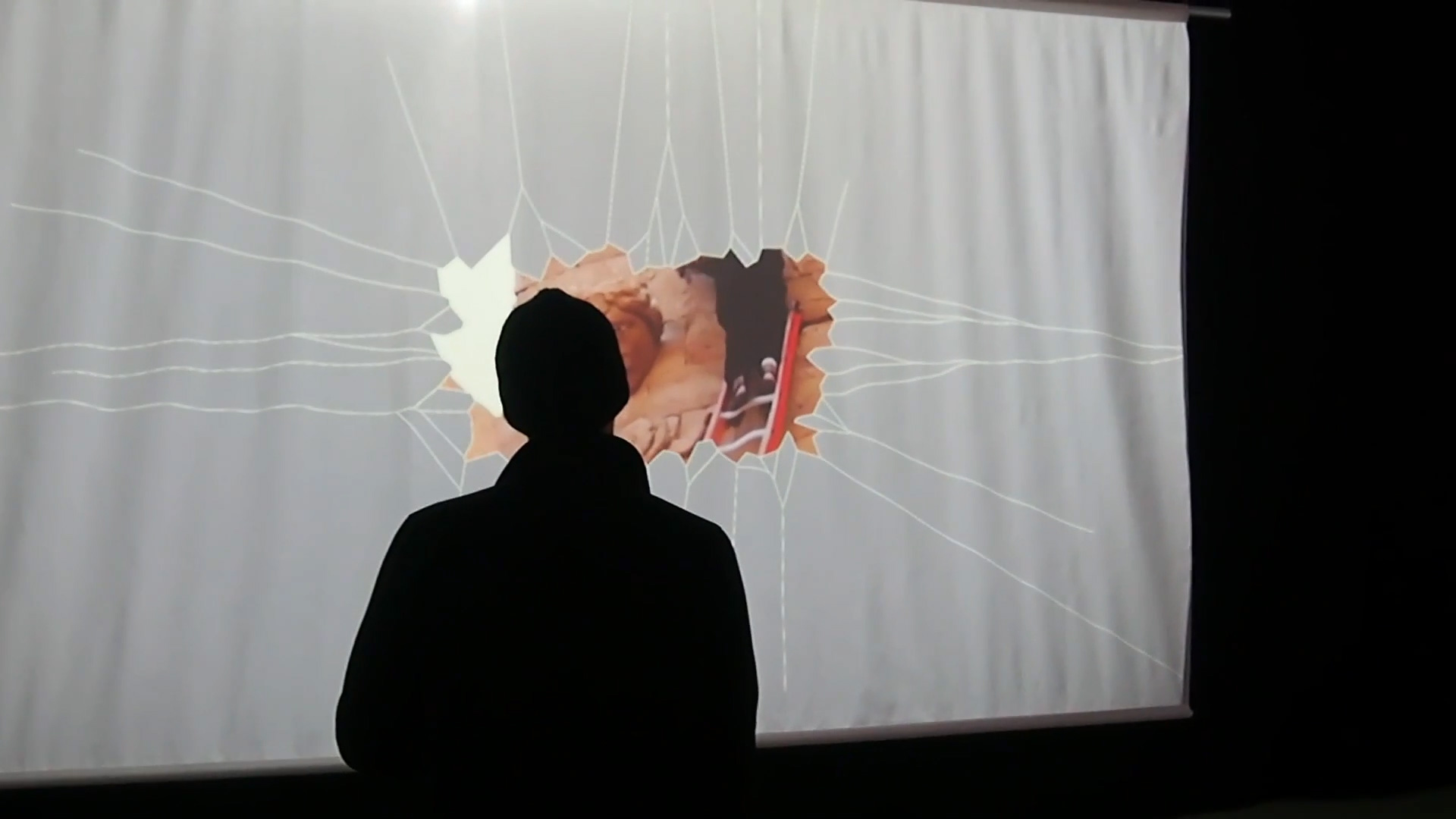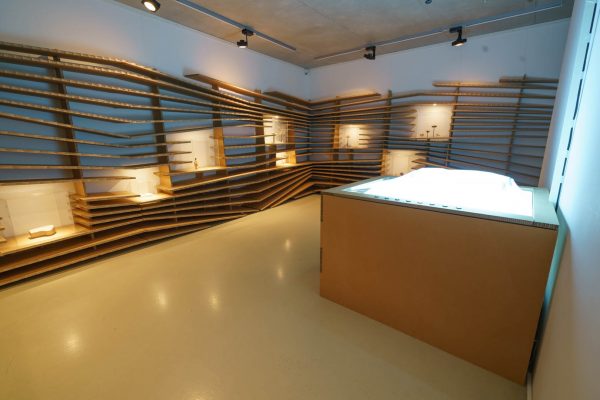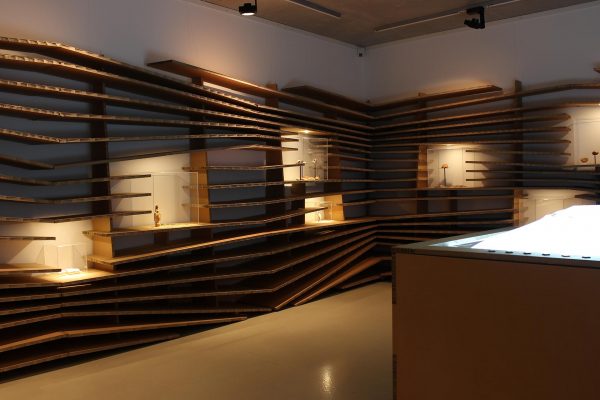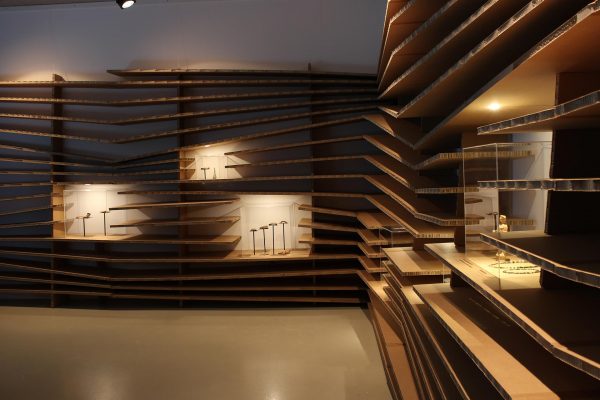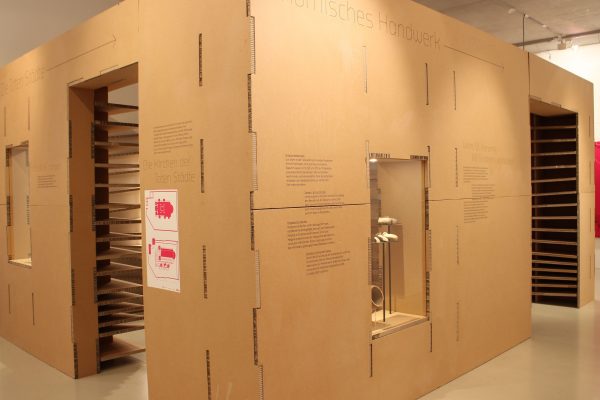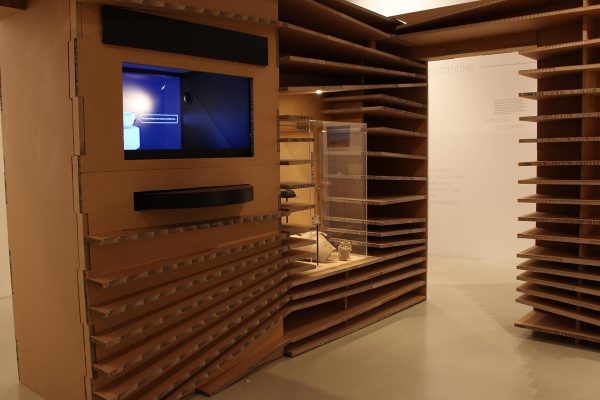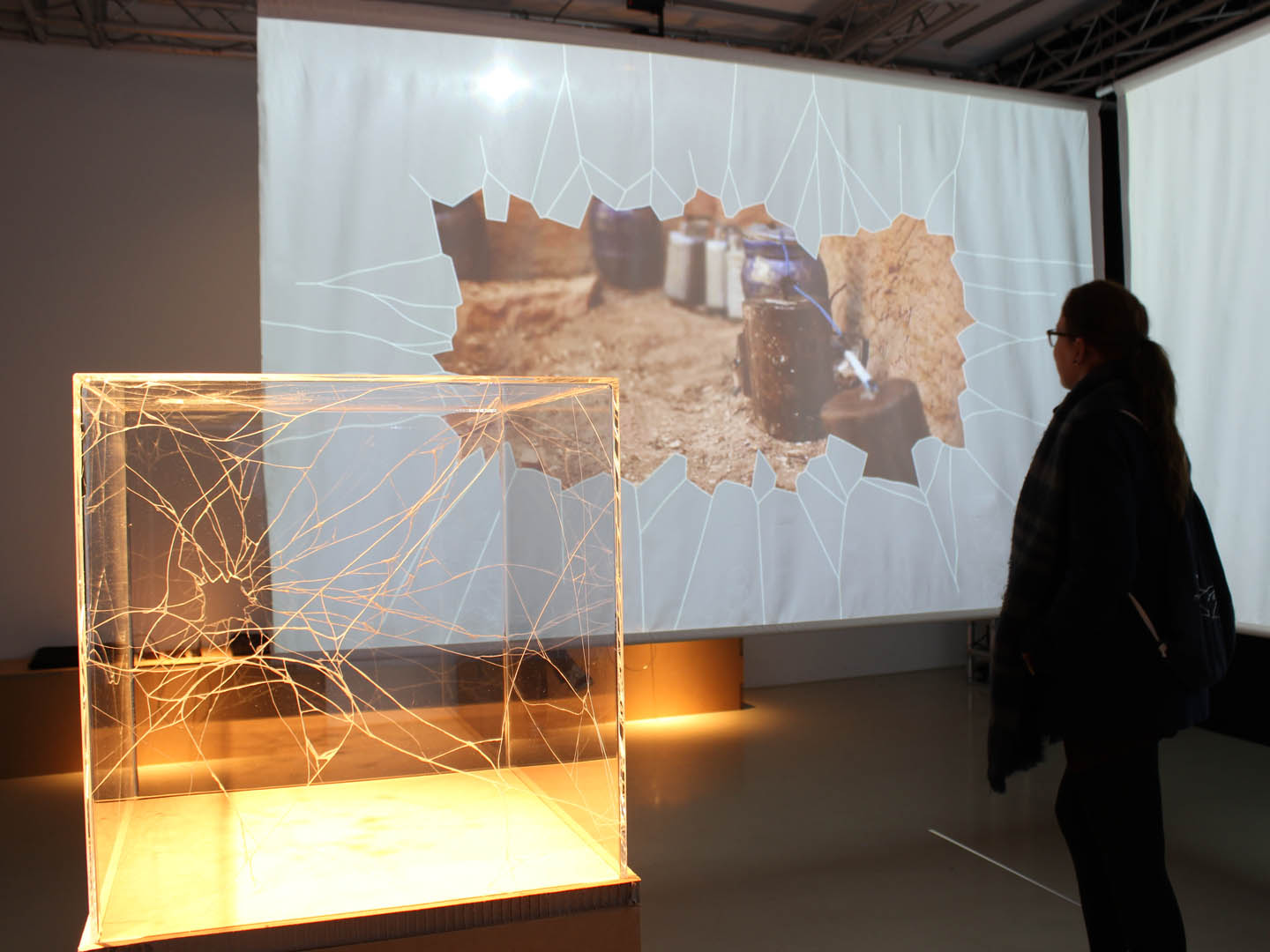Designing A Room-Spanning Interactive Installation
Client
- University of Konstanz
- HTWG Konstanz
Team
- 1 Architect
- 1 Historian
Year
- 2014 – 2016
Tasks
- Design
- Implementation
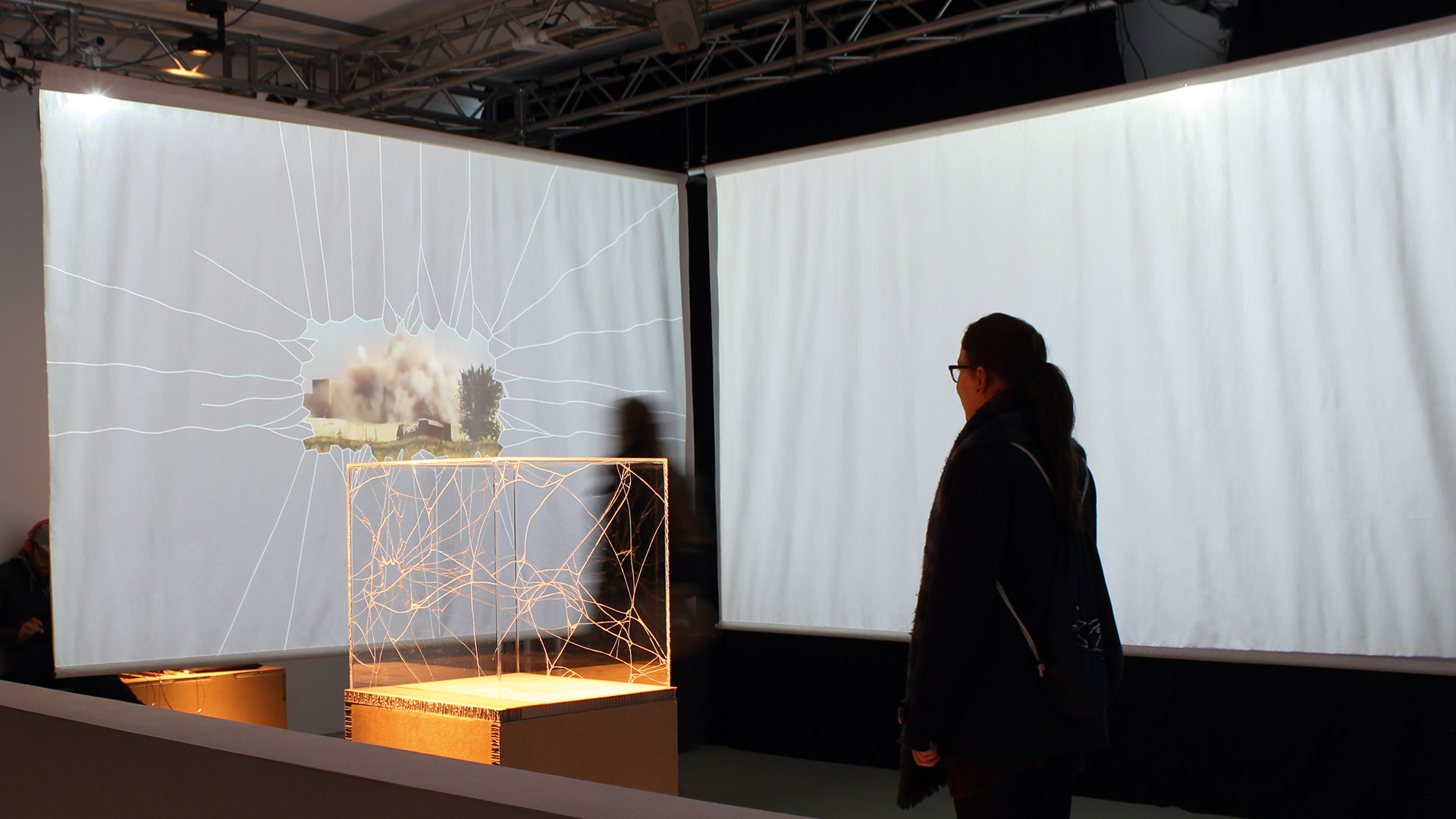
How do we make visitors feel the impact of the destruction of cultural heritage?
The room-spanning interactive installation „Bruch“ (crack) in the last room of the exhibition „Tell Genderes – 20 Meter Menschheitsgeschichte“ (20 meters of human history) lets visitors experience the destruction of cultural heritage in a subtle way. In the center of the room stands an empty, dimly lit, destroyed showcase. It is a metaphor for the destroyed and lost cultural goods. At some distance from it, gauze fabric hangs from the ceiling, imitating the sides of the showcase. Onto this „fabric showcase“, which is stretched around the actual one, virtual glass is projected. When visitors walk towards the actual showcase, they step „into“ the fabric showcase and unintentionally or intentionally break the virtual glass or break it completely. In the latter case, the resulting peephole displays images and video footage of cultural heritage destruction.
The interactive installation Bruch makes visitors feel the destruction of millenniums-old artifacts and therefore Syrian cultural history itself.
Results
The exhibition „Tell Genderes – 20 Meter Menschheitsgeschichte“ was designed by an interdisciplinary team of Architecture, Communication Design, Computer Science, and History students of the University of Konstanz and HTWG Konstanz. I was one of the computer science students and was responsible for the concept and design – together with one architect and one historian – and solely responsible for the development of the interactive installation.
This exhibition was the first I was part of and it really sparked my interest in exhibition design, as it connects an artful approach to design but at the same time, the interactive elements need to be easily understandable for the visitors. I also learned how much I love to work with and get inspired by other disciplines, other approaches, and other ways of looking at things.
The Exhibition
In „Tell Genderes – 20 meters of human history“, students presented results of archaeological excavations of the ancient village of Genderes, located in what is now northern Syria. It was studied in several excavation campaigns by archaeologists from Constance and Syria. Over thousands of years, former inhabitants of the site have formed the hill layer by layer with their remains. Thus, Tell (Arabic for hill) Genderes grew higher and higher. Today, the hill measures 20 meters of human history. In the exhibition, we used various interactive elements such as kinetic installations or interactive storytelling via tablets.
Room 2 and 3 of the exhibition showed – among others – a kinetic table and an installation using the Pepper's Ghost effect.
Bruch
„Bruch“ was the finale of the exhibition, intended to push the visitors to think about the impact of the destruction of cultural heritage and also, about the role, the western world plays in it. Therefore, we designed the installation in a way, that the visitors „stumble“ into interacting with it – their attention is first caught by the empty showcase, they move toward it and only notice that they have an impact when the first glass shatters. Simultaneously, the calm staging of the room invites visitors to stay after the exhibition and talk about their impressions and opinions and watch how other visitors interact with the installation.
Process
Together with an architecture and history student, I was responsible for the design of the installation and later on, solely, for its implementation.
Point of Entry
When we started designing the installation, the exhibition’s overall design was already at an advanced point. Our team knew what we wanted to present in each room, and for the most, even how we wanted to present it. However, the last room remained difficult. We knew that we wanted to make the destruction of cultural heritage the main topic of this room, but at the same time, we didn’t want it to be sensationalist. It was a difficult balance to find since images of exploding buildings are simply more striking to most visitors in comparison to shards of a vase. Consequently, we met in a break-out group to discuss how we can approach the topic and soon came up with the idea of not showing any images of the destruction at first but gradually reveal them. As one of our teammates proposed to place an empty showcase in the center of the room, it quickly came together: „Why do we not let the visitors break a virtual showcase and then show the images of destruction in the cracks?“ Thankfully, the architecture student was very skilled in 3D modeling and quickly created a striking rendering that communicated our idea to the whole team. The team was sold after only a short look at the image.
Feasibility Testing
At first, my plan was to pre-render lots of different „glass-shatter“ animations using Cinema 4D and then play these animations randomly if a person would walk towards the glass. However, testing this in a small-scale prototype showed that it felt a bit static and it was not always clear whether the animations just played or whether it was really the visitor who made them break. Because of this, we made the decision to build a fully interactive „glass-shattering“ application.
Initially, I used Processing sketches to experiment to simulate the cracking of glass using Voronoi patterns.
Simultaneously, I experimented with simple physics simulations for shattering glass.
Implementing the installation
Luckily, at the same time, I was implementing the application for my bachelor’s thesis, Argus Vision. I used this application to track the visitors and then implemented a Processing application that created the glass shatters using Voronoi patterns. While it, of course, didn’t look as realistic as the Cinema 4D renderings, it allowed me to let glass directly break at the point where the users stood. At the same time, I could use the installation as a nice way of evaluating my own bachelor’s project!
A visitor walks past the gauze and cracks the glass at her position. Finally, the glass breaks.
Used Tools
Hardware
3 Short-Distance Projectors, 3 Mini-PCs, 3 Microsoft Kinects
Software
Processing, Argus Vision
Languages
Processing/Java
